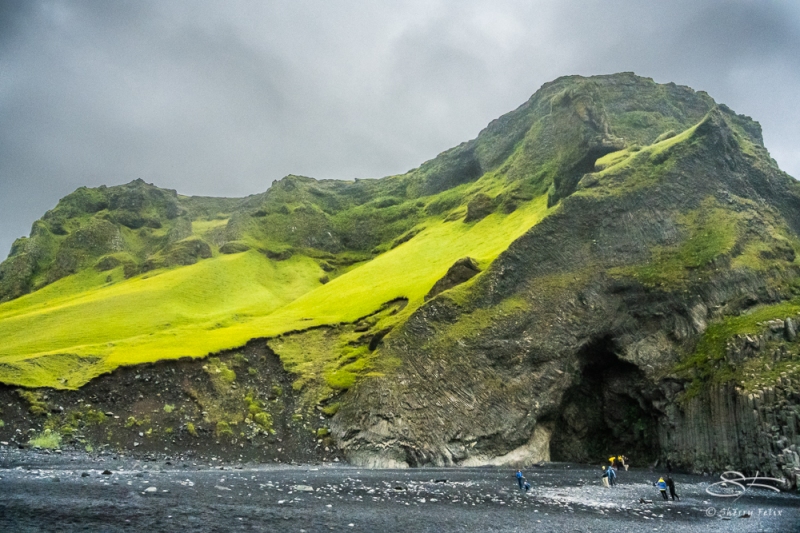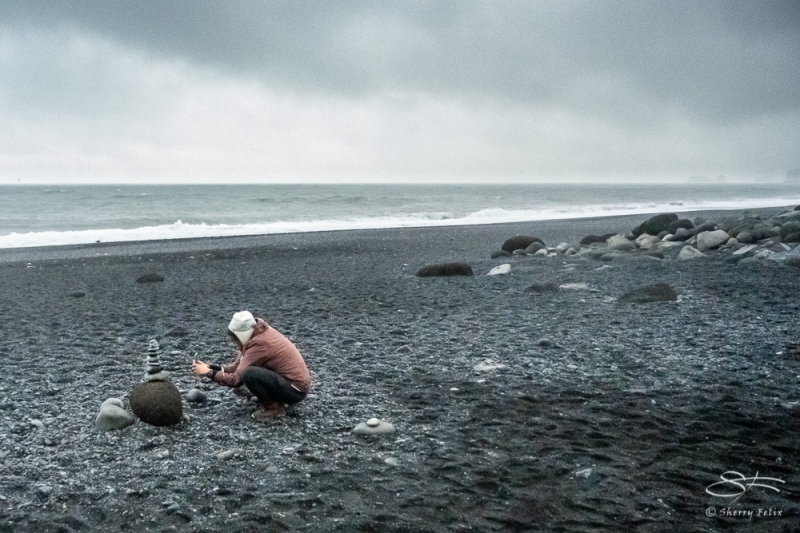On the way out of Reykjavik on July 14 (last of my posts for that day) we passed this interesting church and I took photos of Mofellskirkja in the distance from the Golden Circle.
We stopped at Rutshllir CavesFascinating stories about the man made caves. This one has a hut with a sod roof. Details here: The Peculiar Rútshellir Cave in South Iceland (guidetoiceland.is) Hálsanefshellir Cave is by the Reynisfjara black beach is a huge sea cave located at the beach close to the small town Vík. The cave is exceptional because of octagonal basalt pillars at the cave entrance. The vertical columns are quite similar to Fingal’s Cave on Staffa Island.
In the morning we went back to black sands. There was a fellow there with a drone I’m sure he was not happy to see us as he was the only other person there and I’m sure he wanted it all to himself to take pictures of the Hálsanefshellir Cave. I stepped out to the edge to see if I could go around the point to have a look behind the cave and a wave almost caught me. I realized that these waters were very unpredictable and to try to go around that point would be very dangerous, so I didn’t. This video on shows some people getting washed out to sea by one of these rogue waves: Extremely dangerous Waves by Reynisfjara and Kirkjufjara … (guidetoiceland.is). The water is so cold that within seconds they were unable to move or stand up.
There is also a story associated with the cave about a Seal skin The Seal’s Skin: Icelandic Selkie Folktale (vikingrune.com)
The Nootka lupin was brought to Iceland from Alaska in 1945 to help to restore degraded soils which had been a serious problem since the 19th century. Although there are still large areas in Iceland which suffer erosion and desertification many feel the lupine has become too aggressive and needs to be stopped. It is especially feared that the lupine will spread into the Central highlands, permanently transforming the local flora. It is an invasive species in Iceland, threatening local plant life. It creates monocultures which can suffocate more delicate native flora. Icelanders are trying to destroy the lupine. The goal is to protect the distinctive woolly moss, known in Icelandic as graymoss, which covers the lava. It is not least the luscious moss which gives the lava field its magical aura.
Oystercatchers are seen all over, both by the shore and inland. I do not know why so many appear to like the roads. I wonder what they find there. It is a suicidal behavior that often gets them run over.

Háteigskirkja, Reykjavik, Iceland 7/14/2021 
On the way to Thingvellir 7/14/2021 
On the way to Thingvellir 7/14/2021 
On the way to Thingvellir 7/14/2021 
Mosfellskirkja, Mofellsdalur 7/16/2021 
near Rutshellir Caves 7/14/2021 
Rutshellir Caves 7/14/2021 
Rutshellir Caves 7/14/2021 
Rutshellir Caves 7/14/2021 
Halsanefshellir Cave 7/14/2021 
Halsanefshellir Cave 7/14/2021 
Halsanefshellir Cave 7/14/2021 
Reyisfjara Beach 7/14/2021 
Vik 7/14/2021 
Nootka Lupin (Lupinus nootkatensis), Vik 7/14/2021 
Oystercatchers (Neognathae Haematopodidae Charadriiformes), Vik 7/14/2021